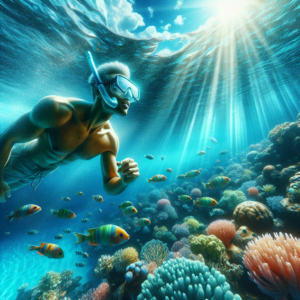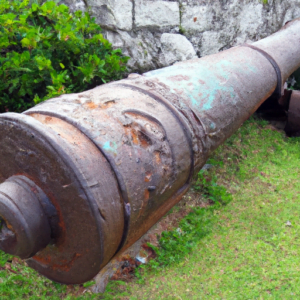Have you ever wondered what lies beneath the surface of Hawaii’s stunning landscapes? In “Discovering the Mysteries of Kilauea: Exploring Hawaii’s Active Volcanoes,” we invite you on an awe-inspiring journey to uncover the secrets of these majestic geological wonders. From the mesmerizing lava flows of Kilauea to the fascinating science behind volcanic islands, prepare to be captivated by the dynamic forces that have shaped these breathtaking landscapes. Lace up your hiking boots and join us as we delve into the world of active volcanoes and embark on a thrilling adventure unlike any other.
Table of Contents
ToggleThe Formation of Hawaiian Islands
1.1. Introduction to the Hawaiian Hotspot
Hawaii’s captivating beauty and unique geology can be traced back to the Hawaiian Hotspot. The Hawaiian Islands are located in the middle of the Pacific Ocean, far away from any tectonic plate boundaries. This hotspot is a stationary source of magma beneath the Earth’s crust, leading to the formation of a chain of volcanic islands. As the Pacific tectonic plate moves northwestward over the hotspot, a new island is formed, creating a chain of islands over millions of years.
1.2. Active Volcanoes: Plate Tectonics and Volcanic Activity
Understanding the relationship between plate tectonics and volcanic activity is key to understanding the formation of the Hawaiian Islands. The Earth’s lithosphere consists of several large plates that float on the semi-fluid asthenosphere beneath them. The Pacific Plate, on which the Hawaiian Islands are located, is moving northwestward at a rate of about 8 centimeters per year. This movement causes the plate to pass over the stationary Hawaiian Hotspot, resulting in volcanic activity and the formation of new islands.
1.3. Birth of the Hawaiian Islands
The birth of the Hawaiian Islands is a fascinating process that begins deep beneath the Earth’s surface. The Hawaiian Hotspot acts as a plume of hot mantle material that rises towards the surface, eventually melting through the overlying crust. As the magma erupts, it forms a shield volcano, which is characterized by gentle slopes and a broad, rounded shape. Over time, as the volcano becomes dormant and erosion takes its toll, a new island begins to form further along the hotspot track. This continuous process has given rise to the chain of islands we see today.
Introduction to Kilauea Volcano
2.1. Location and Geography
Kilauea Volcano, located on the Big Island of Hawaii, is one of the most active volcanoes in the world. It is situated within the Hawai’i Volcanoes National Park, a UNESCO World Heritage Site. Kilauea stands as a magnificent shield volcano, with its summit reaching an elevation of approximately 4,090 feet (1,247 meters) above sea level. The volcano occupies a vast area that extends from its summit down to the ocean, showcasing a diverse range of volcanic features.
2.2. Historical Eruptions
Kilauea has a long history of eruptions, with the earliest documented eruption occurring around 300,000 years ago. Throughout time, numerous eruptions have shaped the landscape of the volcano, creating a dynamic and ever-changing environment. One of the most notable eruptions in modern history was the 2018 eruption, which lasted for several months and resulted in significant changes to the landscape and surrounding communities.
2.3. Types of Volcanic Activity at Kilauea
Kilauea exhibits a variety of volcanic activity, including both effusive and explosive eruptions. Effusive eruptions are characterized by the slow and steady outpouring of lava from fissures or vents, while explosive eruptions involve the violent ejection of material, such as ash and pyroclastic flows. Kilauea’s recent activity has primarily been characterized by effusive eruptions, producing spectacular lava flows that have attracted scientists and visitors alike.
Life on the Edge: Living Near an Active Volcano
3.1. Volcanic Hazards and Risk Management
Living near an active volcano can be both awe-inspiring and risky. Volcanic hazards, such as lava flows, ashfall, and toxic gases, pose significant threats to nearby communities. However, through careful risk management strategies, volcanic hazards can be mitigated to ensure the safety of residents. Building codes, evacuation plans, and monitoring systems are some of the measures in place to minimize the potential impact of volcanic activity on human lives and infrastructure.
3.2. Volcanic Monitoring and Early Warning Systems
Monitoring volcanoes is crucial for understanding their behavior and providing early warning signs of potential eruptions. In the case of Kilauea, a network of sensors and instruments is employed to detect changes in volcanic activity. These monitoring systems include seismometers, gas analyzers, and ground deformation instruments. By continuously monitoring the volcano, scientists can provide timely warnings to residents, allowing them to evacuate if necessary.
3.3. Impact of Volcanoes on the Environment and Local Communities
Volcanic activity has a profound impact on the environment and local communities. Lava flows reshape the landscape, destroying everything in their path while creating opportunities for new life to emerge. The fertility of volcanic soils also provides favorable conditions for agriculture. However, volcanic eruptions can also have negative consequences, such as air pollution from volcanic gases and disruption of ecosystems. Balancing the benefits and risks of living near an active volcano requires careful consideration and planning.
Exploring Kilauea’s Spectacular Features
4.1. Halema’uma’u Crater: The Home of Pele
Halema’uma’u Crater is one of the most iconic features of Kilauea Volcano. Located within the larger summit caldera, it is considered the home of Pele, the Hawaiian goddess of fire and volcanoes. Over the years, the size and shape of the crater have evolved, reflecting the volcano’s activity. Visitors can witness the plumes of gases rising from the crater, creating a mesmerizing spectacle and a reminder of Kilauea’s power.
4.2. Lava Flows and Ocean Entry Points
One of the most captivating sights at Kilauea is the sight of lava flowing into the ocean. When lava meets the cool seawater, it undergoes rapid cooling and solidification, creating new land formations. The creation of new land through the interaction of lava and water offers a rare opportunity to witness the natural processes that shape our planet. Visitors can observe these ocean entry points, while respecting safety restrictions, to witness this awe-inspiring phenomenon.
4.3. Underground Lava Tubes and Caves
Kilauea is renowned for its extensive system of underground lava tubes and caves. These natural features are formed when the outer surface of a lava flow solidifies, while molten lava continues to flow within. As the eruption ceases, the lava drains from the tube, leaving behind a hollow and often intricate cave structure. Exploring these lava tubes and caves provides a unique opportunity to witness the incredible geological history of Kilauea firsthand.
Volcanic Activity and Eruption Phases
5.1. Intraplate Volcanism and the Hotspot Theory
The Hawaiian Islands’ volcanic activity is classified as intraplate volcanism, as it occurs within the interior of the Pacific Plate rather than at plate boundaries. The hotspot theory explains the formation of these intraplate volcanic islands. As the Pacific Plate moves over the stationary hotspot, volcanism occurs, leading to the birth of new islands along the chain. This theory has been supported by various geological evidence, contributing to our understanding of plate tectonics and volcanic processes.
5.2. Stages of Volcanic Eruptions
Volcanic eruptions are classified into different stages based on their behavior and intensity. The initial stage, known as the precursory stage, is characterized by increased volcanic activity, such as ground deformation and increased gas emissions. This is followed by the eruptive stage, where lava may start to flow or explosive eruptions occur. Finally, the waning stage signifies a decrease in volcanic activity until it eventually ceases. Understanding these stages helps scientists predict and monitor volcanic activity.
5.3. Understanding Volcanic Monitoring Data
Interpreting volcanic monitoring data is crucial for understanding the behavior of a volcano and predicting potential eruptions. Seismic activity, ground deformation, gas emissions, and thermal anomalies are among the key indicators used to assess a volcano’s activity. Analyzing these data sets allows scientists to detect patterns and changes that can provide valuable insight into the inner workings of a volcano. Continuous monitoring and analysis of data contribute to our understanding of volcanic activity and the safety of adjacent communities.
Unique Ecosystems and Biodiversity
6.1. Pioneering Life on Lava Fields
The barren and seemingly inhospitable lava fields of Kilauea are a testament to the resilience of life. Despite the harsh conditions, pioneering plants and animals have adapted to colonize these barren landscapes. Mosses, ferns, and certain flowering plants are among the first to establish themselves on the newly formed lava. Over time, their presence facilitates the accumulation of soil and nutrient-rich environments, allowing for the colonization of a more diverse range of species.
6.2. Adaptations of Plants and Animals
The plants and animals of Kilauea have evolved unique adaptations to survive in the challenging volcanic environment. Many plants have developed the ability to quickly establish their root systems and absorb nutrients from the nutrient-poor lava soil. Insects and birds have also adapted to feed on the nectar of flowers that grow on the volcano’s slopes. These adaptations highlight the remarkable resilience and adaptability of life in the face of extreme conditions.
6.3. Impact of Volcanic Activity on Biodiversity
Volcanic activity, while destructive in the short term, plays a vital role in creating and shaping biodiversity in the long run. Volcanic eruptions bring new substrates to the surface, introducing fresh minerals and nutrients that support the growth of new plant species. As these new plant communities establish themselves, they attract insects and birds, leading to the development of diverse ecosystems. Consequently, volcanic activity is a key driver of biodiversity, contributing to the uniqueness of Hawaiian flora and fauna.
Cultural Significance of Kilauea
7.1. Pele, the Hawaiian Goddess of Fire
Pele, the Hawaiian goddess of fire and volcanoes, holds a significant place in the hearts and spirituality of the Hawaiian people. She is believed to reside in the Halema’uma’u Crater, and her presence is deeply intertwined with the mythology and cultural practices of the Hawaiian Islands. Pele is both revered and feared, with her stories and legends passing down through generations, serving as a reminder of the power and unpredictability of nature.
7.2. Ancient Hawaiian Legends and Myths
Kilauea’s volcanic activity has inspired numerous ancient Hawaiian legends and myths. These stories, passed down orally through generations, often feature Pele and her fiery temperament. From tales of forbidden love to epic battles between gods and goddesses, these legends embody the cultural significance of Kilauea and its place in Hawaiian mythology. Exploring these myths provides a deeper understanding of the spiritual connection between the people and the volcano.
7.3. Cultural Practices and Offerings
Today, the cultural practices associated with Kilauea are an intrinsic part of Hawaiian heritage. The Hawaiian people continue to engage in ceremonies, rituals, and offerings dedicated to Pele as a sign of respect and acknowledgement of the volcano’s power. Offerings such as hula dances, chants, and flowers are made to express gratitude and seek protection. These cultural practices serve as a reminder that Kilauea is not only a geological phenomenon but also a spiritual and cultural symbol for the Hawaiian people.
Volcano Tourism and Visitor Information
8.1. Volcano National Park: Visitor Center and Attractions
Hawaii Volcanoes National Park offers visitors a unique opportunity to explore the breathtaking beauty and geology of Kilauea. The park’s visitor center provides valuable information on the volcano’s history, volcanic hazards, and safety guidelines. Exhibits and displays offer insights into the geological processes that shape the Hawaiian Islands. Visitors can also embark on ranger-led programs to discover the diverse flora and fauna found within the park.
8.2. Guided Tours and Volcano Hiking
Guided tours and hiking are popular activities for visitors to Kilauea. Knowledgeable guides lead tours through the park, providing in-depth information on the volcano’s features, natural history, and cultural significance. Hiking trails allow visitors to explore lava fields, witness volcanic vents, and experience the power and grandeur of the volcanic landscape. These guided experiences offer a safe and enriching way to immerse oneself in the wonders of Kilauea.
8.3. Safety Precautions for Exploring Kilauea
Visiting an active volcano requires adherence to safety precautions to ensure a safe and enjoyable experience. It is essential to stay within designated areas and follow the guidance of park rangers. Volcanic hazards, such as unstable ground, toxic gases, and sudden eruptions, pose potential risks. Visitors should also be prepared for changing weather conditions and carry essentials such as water, sunscreen, and appropriate footwear. By being mindful of safety measures, visitors can fully appreciate the marvels of Kilauea while minimizing potential risks.
Recent Volcanic Activities and Research
9.1. Kilauea’s 2018 Eruption
One of the most significant recent volcanic events at Kilauea occurred in 2018. This eruption, which lasted for several months, resulted in the destruction of hundreds of homes and the reshaping of the volcano’s landscape. Lava flows consumed entire communities and created new land formations, dramatically altering the geography of the region. The 2018 eruption served as a reminder of the unpredictable and dynamic nature of Kilauea.
9.2. Impact on Communities and Environment
The 2018 eruption of Kilauea had a profound impact on the local communities and the environment. Thousands of residents were displaced, and many lost their homes as lava engulfed entire neighborhoods. The eruption also caused widespread air pollution, with volcanic gases and ash affecting air quality. The destruction of natural habitats disrupted local ecosystems, displacing wildlife and threatening the delicate balance of biodiversity. The long-term effects of the eruption continue to be studied by scientists and researchers.
9.3. Ongoing Research and Scientific Discoveries
Kilauea remains an active area of scientific research, providing valuable insights into the processes and behavior of volcanoes. Ongoing monitoring efforts contribute to the understanding of volcanic activity and enable scientists to improve eruption predictions, minimizing the impact on nearby communities. Research also focuses on the environmental impact of volcanic activity, including the reestablishment of ecosystems and the recovery of biodiversity. Through ongoing research, scientists are constantly uncovering new discoveries and expanding our knowledge of Kilauea and its role in shaping the Hawaiian Islands.
Conservation and Protection Efforts
10.1. Preserving Volcanic Landscapes and Endangered Species
Preserving the unique volcanic landscapes of Kilauea is essential for the protection of biodiversity and the cultural heritage of the Hawaiian Islands. Conservation efforts focus on maintaining the integrity of the volcano’s ecosystems, protecting endangered species, and restoring habitats damaged by volcanic activity. This includes initiatives such as replanting native vegetation, controlling invasive species, and monitoring the populations of endangered animals. By preserving these volcanic landscapes, we can ensure the long-term survival of the diverse flora and fauna that call Kilauea home.
10.2. Sustainable Tourism and Responsible Volcano Visits
Sustainable tourism is essential for the preservation of Kilauea’s natural and cultural resources. It involves responsible travel practices that minimize negative impacts on the environment and local communities while promoting positive contributions. Visitors can contribute to sustainable tourism by respecting park guidelines, staying on designated trails, and supporting local businesses that prioritize environmental conservation. By engaging in responsible volcano visits, we can enjoy the wonders of Kilauea while ensuring its preservation for future generations.
10.3. Future Challenges and Opportunities
The preservation and protection of Kilauea face both challenges and opportunities in the future. As volcanic activity continues, the potential risks to adjacent communities and infrastructure need to be carefully managed. Balancing the needs of residents, preserving cultural practices, and maintaining the natural beauty of the volcano presents ongoing challenges. However, with advancements in scientific research, risk mitigation strategies, and community engagement, there are also significant opportunities to promote sustainable development, educate visitors, and ensure the continued success of conservation efforts in Kilauea and beyond.
In conclusion, exploring the mysteries of Kilauea offers a captivating journey into the world of active volcanoes. From its formation through the Hawaiian Hotspot to its dynamic eruptions and unique biodiversity, Kilauea showcases the power and beauty of nature. With proper safety precautions and respect for the cultural significance of the volcano, visitors can marvel at its extraordinary features while contributing to its preservation for future generations. The ongoing research and conservation efforts surrounding Kilauea provide invaluable knowledge and guidance in protecting this remarkable natural wonder. So, embrace the opportunity to discover Kilauea and witness the awe-inspiring wonders of Hawaii’s active volcanoes.





